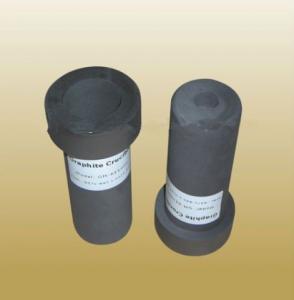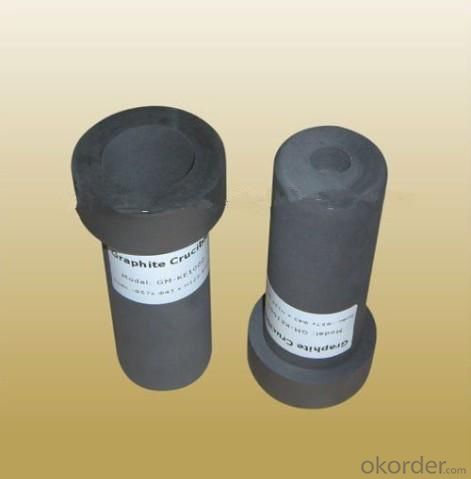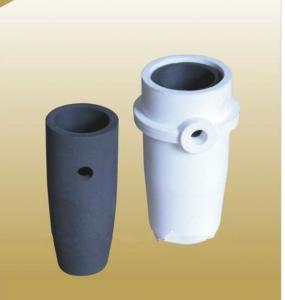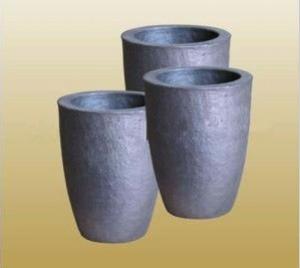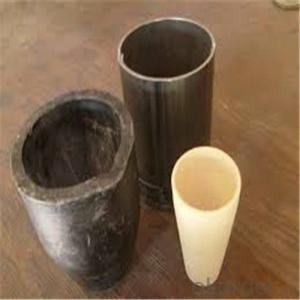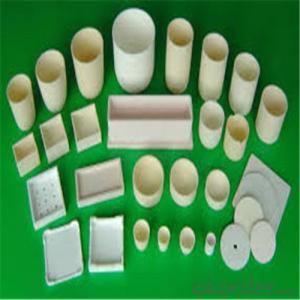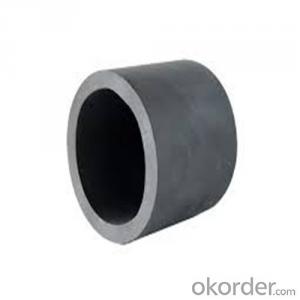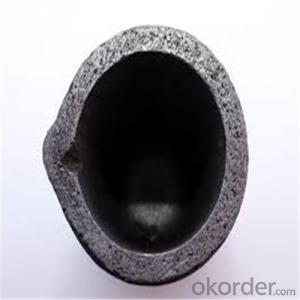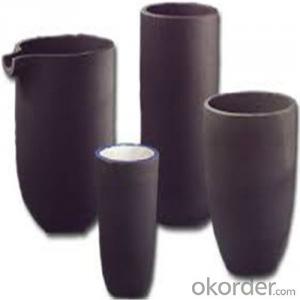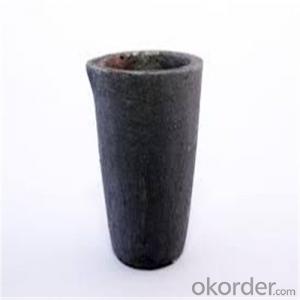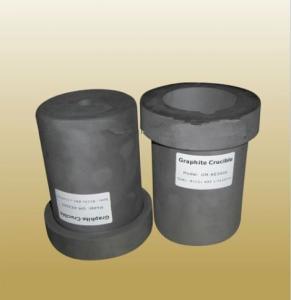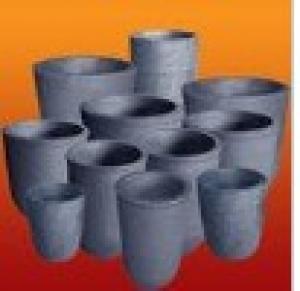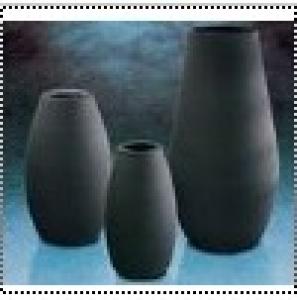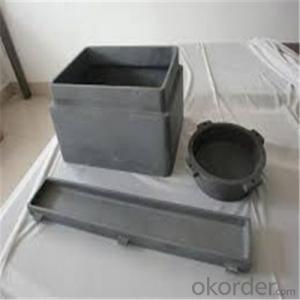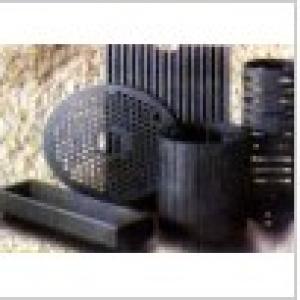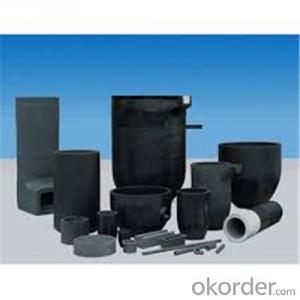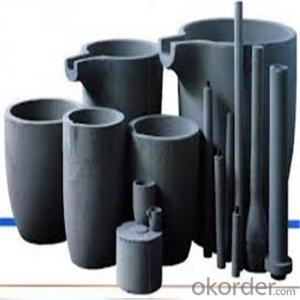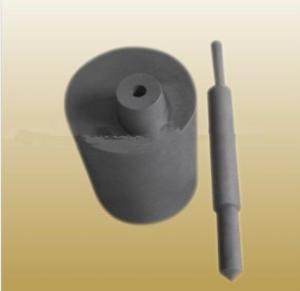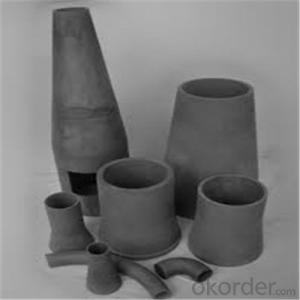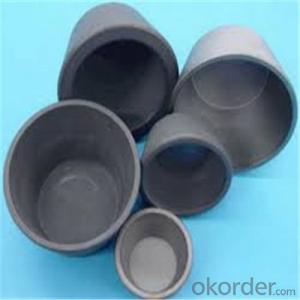30 oz Kerr Graphite Crucible
- Loading Port:
- China Main Port
- Payment Terms:
- TT or LC
- Min Order Qty:
- 50 Pieces pc
- Supply Capability:
- 10000 Pieces per Month pc/month
OKorder Service Pledge
Quality Product, Order Online Tracking, Timely Delivery
OKorder Financial Service
Credit Rating, Credit Services, Credit Purchasing
You Might Also Like
Detailed Product Description
Graphite Crucible with 30 oz/1kg melting capacity which could fit Kerr electro melt oven to melting gold, silver, copper.,etc.
Graphite Crucible 1 Kilo, Fits Kerr Electric Auto Furnace
Item Description
- Graphite Crucible 1 Kilo, Fits Electric Auto Furnace.
- This is a new Graphite Crucible designed for the Hand held Melting Furnace.
- Can be used for all metal types, like gold ,silver,copper etc.
- This model has the groove in the top for the wire type crucible tongs.
- Measurements :
- Top outside diameter (mm) : 57mm
- Top inside diameter (mm) : 43 mm
- Height with the top (mm) : 125.9mm
- Q: What graphite crucible is used to smelt aluminium by electromagnetic induction heating?
- Electromagnetic induction heating is the heating of graphite, and can soon rise to 1000 degrees, but aluminum is a magnetic material, will block the electromagnetic field, so this scheme is not feasible
- Q: What is the recommended stirring method for a graphite crucible?
- The recommended stirring method for a graphite crucible is to use a graphite rod or paddle to gently and continuously stir the contents in a circular motion.
- Q: Can graphite crucibles be used for precious metal refining?
- Yes, graphite crucibles can be used for precious metal refining. Graphite crucibles are commonly used in the metallurgical industry due to their high temperature resistance and chemical inertness. They can withstand the intense heat required for the refining process and prevent contamination of the precious metals.
- Q: Can a graphite crucible be used for powder injection molding?
- Yes, a graphite crucible can be used for powder injection molding. Graphite is a popular choice for crucibles in various high-temperature applications due to its excellent thermal conductivity, high melting point, and low chemical reactivity. In powder injection molding, a graphite crucible can withstand the high temperatures required for the process, typically ranging from 1300 to 1600 degrees Celsius. Additionally, graphite crucibles provide good resistance to thermal shock and can effectively contain the molten feedstock during the injection molding process. Overall, using a graphite crucible in powder injection molding is a suitable option due to its favorable characteristics and compatibility with the required operating conditions.
- Q: What are the different methods of protecting the surface of a graphite crucible?
- There are several methods of protecting the surface of a graphite crucible to ensure its longevity and prevent any contamination or damage. Here are some of the different methods commonly used: 1. Coating: Applying a protective coating to the surface of the graphite crucible is one of the most popular methods. Different types of coatings can be used, such as boron nitride, silicon carbide, or refractory metals like tungsten or molybdenum. These coatings act as a barrier, preventing the crucible from reacting with the materials being melted or causing contamination. 2. Glazing: Glazing involves applying a layer of glass or ceramic material to the surface of the crucible. This creates a protective barrier that helps reduce chemical reactions and corrosion. Glazing is commonly used for applications involving aggressive chemicals or high-temperature environments. 3. Oxidation: Oxidizing the surface of the graphite crucible can provide protection against certain reactive materials. This process involves exposing the crucible to high temperatures in an oxygen-rich environment, forming a thin layer of oxidized graphite on the surface. This layer acts as a barrier to prevent further oxidation or chemical reactions. 4. Preheating: Preheating the graphite crucible before use can help to eliminate any moisture or impurities present on the surface. It also helps to stabilize the crucible, reducing the risk of thermal shock and cracking. 5. Proper handling and storage: Another important method of protecting the graphite crucible is through proper handling and storage. Avoiding rough handling, excessive impacts, or dropping the crucible can prevent physical damage. Proper storage in a clean and dry environment is also crucial to prevent contamination or deterioration. Overall, utilizing a combination of these methods can greatly enhance the lifespan and performance of a graphite crucible, ensuring it remains in optimal condition for various applications in industries such as metallurgy, foundries, and laboratories.
- Q: Is it possible to customize the shape or design of a graphite crucible?
- Yes, it is possible to customize the shape or design of a graphite crucible. Graphite is a highly versatile material that can be molded and shaped into various forms. Graphite crucibles are often used in industries such as metallurgy, foundries, and laboratories for melting and casting metals. To customize the shape or design of a graphite crucible, manufacturers use specialized techniques such as CNC machining or graphite molding. CNC machining involves using computer-controlled machines to precisely shape the graphite material into the desired form. This method allows for highly accurate and complex designs to be created. Alternatively, graphite molding is a process that involves compressing graphite powder into a specific shape using a mold. This method is often used for simpler and more standard crucible shapes. Customization of graphite crucibles can include altering the dimensions, adding handles or spouts, or creating unique designs to suit specific applications. The customization process allows for the crucible to be tailored to the specific requirements of the user, ensuring optimal performance and efficiency. It is worth noting that while customizing the shape or design of a graphite crucible is possible, it may come with additional costs and lead times. This is because the customization process requires specialized equipment and expertise. Therefore, it is essential to communicate with the manufacturer or supplier to discuss the customization options, feasibility, and any associated costs.
- Q: Is pig iron smelted in a graphite crucible?
- The iron obtained directly from ore smelting is called pig iron. As the iron ore, coke, limestone and so on are mixed together, the molten iron is in direct contact with coke, slag, etc., and carbon, sulfur and other elements in the coke will seep into the molten iron. At the same time, the chemical gas in the furnace gas will react with the iron, and the products will also be mixed into the molten iron. Therefore, the impurity content in pig iron is higher, and the main impurities are five basic elements, such as carbon, silicon, manganese, sulfur and phosphorus, as well as some non-metallic inclusions.
- Q: To sum up the different uses (and causes) of various crucibles in ChemistryQuartz glass crucibles, for examplealumina crucibleGlass crucibles, iron crucibles, and the like are different and should be noted
- Molten material with acid as flux (such as K2S, 207, etc.)Porcelain crucible: 1., heat resistance of about 1200 degrees2. suitable for K2S207 and other acidic substances melting samples3. generally can not be used for Na0H, Na202, Na2CO3 and other alkaline substances for melting flux, so as not to corrode the porcelain crucible. Porcelain crucible can not be contacted with hydrofluoric acid4. porcelain crucible can be diluted HCl boiling cleaningIron Crucible: iron does not react with sodium hydroxide, iron crucible can melt caustic soda, and iron crucible is used at 400 degrees or more. It is not economical, even if it is not melted, it also oxidizes rapidlyGraphite crucible: universal type graphite crucible and graphite crucible shaped and high pure graphite crucible three. Graphite crucible of various types, due to performance, and the use of different conditions, the raw material used, production method, technology and product specifications are different. Shi Mogan Guo is the main raw material, is the crystallization of natural shape it is graphite. It maintains the physicochemical properties of all kinds of natural right. That is: the original ink has good thermal conductivity and high temperature resistance, high temperature in use process, small thermal expansion coefficient, thermal quenching of, has a certain anti strain properties. The acid alkali solution, the corrosion resistance is strong, excellent chemical stability. The graphite crucible, because has more excellent performance, so in casting, metallurgy, machinery, chemical and other industrial sectors, is widely used for smelting alloy tool steel and non-ferrous metal and alloy smelting and has good. Technical and economic results
- Q: Is it possible to achieve controlled pouring with a graphite crucible?
- Yes, it is possible to achieve controlled pouring with a graphite crucible. Graphite crucibles are widely used in various industries, including metal casting and melting, due to their unique properties. Graphite has a high melting point, excellent thermal conductivity, and good resistance to thermal shock, making it suitable for handling high-temperature materials. To achieve controlled pouring with a graphite crucible, several factors need to be considered. Firstly, the crucible should be properly preheated to the desired pouring temperature. This ensures that the molten material remains at the desired temperature during pouring, preventing premature solidification. Secondly, the design of the crucible and its pouring lip should allow for precise control over the flow of the molten material. The pouring lip can be shaped to achieve a steady and controlled stream, reducing the risk of splashing or spilling. Furthermore, the operator's skill and experience play a crucial role in achieving controlled pouring. They need to have a good understanding of the material being poured, its characteristics, and the appropriate pouring techniques. They should also be aware of any potential hazards and take necessary precautions to ensure safety during the pouring process. In summary, while achieving controlled pouring with a graphite crucible is possible, it requires proper preheating, appropriate crucible design, and skilled operators. By considering these factors, it is possible to achieve precise and controlled pouring for various applications.
- Q: Can a graphite crucible be used for silver melting?
- Indeed, silver melting can be accomplished by employing a graphite crucible. In the realm of high temperature tasks, such as the melting of silver and various other metals, graphite crucibles are widely utilized. Graphite, with its elevated melting point and exceptional thermal conductivity, proves to be an optimal choice for the task of silver melting and refining. It is worth mentioning that graphite crucibles exhibit commendable resistance to thermal shock, thus enduring rapid heating and cooling cycles without succumbing to cracks or fractures. Nevertheless, it is of utmost importance to bear in mind that proper preparation and conditioning of the graphite crucible is essential prior to employing it for silver melting, as this will prevent any impurities from tainting the silver.
We are always keeping enlarging production scale, perfecting management system, and improving office facilities to expand our markets both at home and abroad.We sincerely welcome clients at home and abroad to come for negotiations.
1. Manufacturer Overview
| Location | Guangdong,China (Mainland) |
| Year Established | 2010 |
| Annual Output Value | |
| Main Markets | North America South America Eastern Europe Southeast Asia Africa Oceania Mid East Eastern Asia Western Europe |
| Company Certifications |
2. Manufacturer Certificates
| a) Certification Name | |
| Range | |
| Reference | |
| Validity Period |
3. Manufacturer Capability
| a) Trade Capacity | |
| Nearest Port | |
| Export Percentage | 61% - 70% |
| No.of Employees in Trade Department | |
| Language Spoken: | |
| b) Factory Information | |
| Factory Size: | 1,000-3,000 square meters |
| No. of Production Lines | Above 10 |
| Contract Manufacturing | OEM Service Offered |
| Product Price Range | |
Send your message to us
30 oz Kerr Graphite Crucible
- Loading Port:
- China Main Port
- Payment Terms:
- TT or LC
- Min Order Qty:
- 50 Pieces pc
- Supply Capability:
- 10000 Pieces per Month pc/month
OKorder Service Pledge
Quality Product, Order Online Tracking, Timely Delivery
OKorder Financial Service
Credit Rating, Credit Services, Credit Purchasing
Similar products
Hot products
Hot Searches
Related keywords
